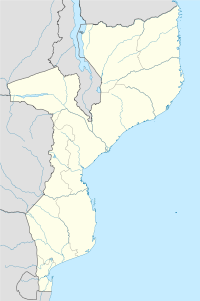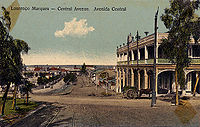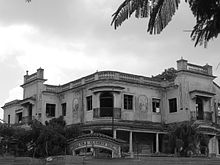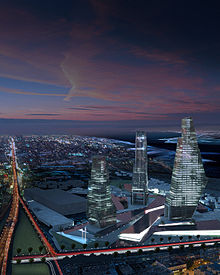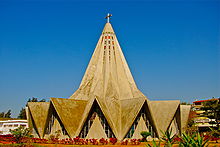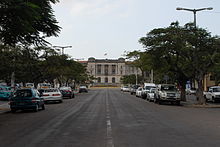- Maputo
-
Maputo
Lourenço Marques— City — Nickname(s): City of Acacias Location in Mozambique Coordinates: 25°58′S 32°35′E / 25.967°S 32.583°ECoordinates: 25°58′S 32°35′E / 25.967°S 32.583°E Country  Mozambique
MozambiqueGovernment – Municipal Council President David Simango Area – Total 346 km2 (133.6 sq mi) Population (2006) – Total 1,244,227 Time zone CAT (UTC+2) Area Code & Prefix (+258) 21-XX-XX-XX ISO 3166 code MZ Maputo, also known as Lourenço Marques, is the capital and largest city of Mozambique. It is known as the City of Acacias in reference to acacia trees commonly found along its avenues and the Pearl of the Indian Ocean. It was famous for the inscription "This is Portugal" on the walkway of its municipal building. Today it is a port city on the Indian Ocean, with its economy centered around the harbour. According to the 2007 census, the population is 1,766,184.[1] Cotton, sugar, chromite, sisal, copra, and hardwood are the chief exports. The city manufactures cement, pottery, furniture, shoes, and rubber. The city is surrounded by Maputo Province, but is administered as its own province.
It is estimated that 80% of the city's population lives in slums without running water or electricity, but the city has little money to invest in infrastructure.[2] Inequality in Maputo has grown considerably as it experienced economic growth rates as high as 9% annually.[2]
Contents
Geography
Maputo is located on the west side of Maputo Bay, near the Estuário do Espírito Santo where the rivers Tembe, Umbeluzi, Matola and Infulene drain. The bay is 95 kilometers long and 30 kilometers wide. At the extreme east of the city and bay is the island of Inhaca.The total area covered by the municipality of Maputo is 346 km² and borders the city of Matola northeast and east, the districts of Marracuene to the north; Boane in the east and Matutuíne at the south all of which are part of Maputo Province. The city is 120 kilometers from the South African border at Ressano Garcia and 80 kilometers from the border with Swaziland near the town of Namaacha.
The city is divided into seven main administrative divisions. Each of these consists of several smaller city quarters or bairros.
Administrative Division City Quarters or Bairros KaMpfumo Central A/B/C - Alto Maé A/B - Malhangalene A/B - Polana Cimento A/B - Coop - Sommerschield Nlhamankulu Aeroporto A/B - Xipamanine - Minkadjuíne - Unidade 7 - Chamanculo A/B/C/D - Malanga - Munhuana KaMaxaquene Mafalala - Maxaquene A/B/C/D - Polana Caniço A/B - Urbanização KaMavota Mavalane A/B - FPLM - Hulene A/B - Ferroviário - Laulane - 3 de Fevereiro - Mahotas - Albazine - Costa do Sol KaMubukwana Bagamoyo - George Dimitrov (Benfica) - Inhagoia A/B - Jardim - Luís Cabral - Magoanine - Malhazine - Nsalene - 25 de Junho A/B(Choupal) - Zimpeto KaTembe Gwachene - Chale - Inguice - Ncassene - Xamissava KaNyaka Ingwane - Ribjene - Nhaquene History
Portuguese rule
On the northern bank of Espírito Santo Estuary of Delagoa Bay, an inlet of the Indian Ocean, Lourenço Marques was named after the Portuguese navigator, who with a companion (António Caldeira) was sent in 1544 by the governor of Mozambique on a voyage of exploration. They explored the lower courses of the rivers emptying their waters into Delagoa Bay, notably the Espírito Santo. The various forts and trading stations which the Portuguese established, abandoned and reoccupied on the north bank of the river were all called Lourenço Marques. The existing town dates from about 1850, the previous settlement having been entirely destroyed by the natives. The town developed around a Portuguese fortress completed in 1787.
In 1871 the town was described as a poor place, with narrow streets, fairly good flat-roofed houses, grass huts, decayed forts and rusty cannon, enclosed by a wall 6 ft. high then recently erected and protected by bastions at intervals. The growing importance of the Transvaal led, however, to greater interest being taken in Portugal in the port. A commission was sent by the Portuguese government in 1876 to drain the marshy land near the settlement, to plant the blue gum tree, and to build a hospital and a church. A city since 1887, it superseded the Island of Mozambique as the capital of Mozambique in 1898. In 1895, construction of a railroad to Pretoria, South Africa caused the city's population to grow.
In the early 1900s, with a well equipped seaport, with piers, quays, landing sheds and electric cranes, enabling large vessels to discharge cargoes direct into the railway trucks, Lourenço Marques developed under Portuguese rule and achieved great importance as a lively cosmopolitan city. It was served by British, Portuguese and German liners, and the majority of its imported goods were shipped at Southampton, Lisbon and Hamburg. With the continuous growth of the city's population and its expanding economy centered on the seaport, from the 1940s, Portugal's administration built a network of primary and secondary schools, industrial and commercial schools as well as the first university in the region - the University of Lourenço Marques opened in 1962. Portuguese, Islamic (including Ismailis), Indian (including from Portuguese India) and Chinese (including Macanese) communities managed to achieve great prosperity - but not the unskilled African majority - by developing the industrial and commercial sectors of the city. Prior to Mozambique's independence in 1975, thousands of tourists from South Africa and Rhodesia (now Zimbabwe) frequented the city and its scenic beaches, high-quality hotels, restaurants, casinos and brothels.[3][4] The Mozambique Liberation Front, or FRELIMO, formed in Tanzania in 1962. Led by Eduardo Mondlane, FRELIMO fought for independence from Portuguese rule. The Mozambican War of Independence lasted over 10 years, ending only in 1974 when the Estado Novo regime was overthrown in Lisbon by a leftist military coup - the Carnation Revolution. The new government of Portugal granted independence to all Portuguese overseas territories.
After independence from Portugal
The People's Republic of Mozambique was proclaimed on 25 June 1975 in accordance with the Lusaka Accord signed in September 1974. A parade and a state banquet completed the independence festivities in the capital, which was expected to be renamed Can Phumo, or "Place of Phumo," after a Shangaan chief who lived in the area before the Portuguese navigator Lourenço Marques first visited the site in 1545 and gave his name to it.[5] However, after independence, the city's name was changed (in February 1976) to Maputo. Maputo's name reputedly has its origin in the Maputo River. The statues to Portuguese heroes were removed and most were stored at the fortress, and black soldiers carrying Russian rifles replaced Portuguese Army soldiers (both black and white) with western arms in city barracks and on the streets. Most city streets, named for Portuguese heroes or important dates in Portuguese history, had their names changed too.
After the Carnation Revolution in Lisbon, over 250,000 ethnic Portuguese pulled out virtually overnight,[5] leaving unmanageable Mozambique's economy and administration. With the exodus of trained Portuguese personnel, the newly independent country had no time to allocate resources in order to maintain its well-developed infrastructure. In addition, authoritarian Marxist policies and failed central planning made the newly independent country slip into an extremely precarious condition since the beginning, and so the economy plummeted. FRELIMO, now the governing party, turned to the communist governments of the Soviet Union and East Germany for help. By the early 1980s the country was bankrupt. Money was worthless and shops were empty. Starting shortly after independence, the country was plagued from 1977 to 1992 by a long and violent civil war opposing FRELIMO to RENAMO - the Mozambican Civil War.
Since the peace agreement was signed in 1992, the country has returned to its pre-independence levels of political stability. This level of stability is an encouraging sign that makes Mozambique a promising country for foreign investment.[6]
Infrastructure
The central area of Maputo corresponds to a planned city with square blocks and wide avenues, with Portuguese traces and their typical architecture of the 1970s. After the Carnation Revolution (1974) military coup in Lisbon, Portuguese refugees fled in massive numbers close to the date of independence (1975), and the resultant lack of skills and capital, in the context of a fierce civil war and government mismanagement, contributed to its state of dereliction in the years following these events. Nevertheless, the city itself was never damaged, since it was tacitly considered neutral ground during both the colonial and the civil war.
Recovery of the older infrastructure has been slow and most property developers in recent years have decided to invest in the construction of new properties rather than rehabilitating any of the existing ones. The rates for property in the city are high as investment increases, larger numbers of businesses are hoping to locate within easy reach of the airports, banks and other facilities. The infrastructure is expected to spread out across vacant areas of the city hopefully easing property prices within the next couple of years.
PROMAPUTO
In 2007, the municipality of Maputo began a project to seriously consider rehabilitating the city's infrastructure. PROMAPUTO was a project that began as co-operation between the local city council and the International Development Association (IDA) of the World Bank. The first phase (PROMAPUTO1) took place between 2007 and 2010 and was chiefly concerned with developing the systems, knowledge and planning required to support the gradual overhaul of the infrastructure. The project was broken into several key areas and a budget allocated to each of these, namely: Institutional Development, Financial Sustainability, Urban Planning, Urban Infrastructure Investment and Maintenance, Metropolitan Development (services such as waste collection and disposal). The total financial allocation for this phase was USD 30 million.
In 2011, PROMAPUTO2, the second phase of the project began. This phase is to last until 2015 and a total of USD 105 million will be invested. A special Integrated Financial Management Information System (IFMIS) will be developed and implemented together with Geographic Information System (GIS). These systems will help the municipality control its budgets and manage tenders, while the GIS will allow for precise information about land location and titling to be kept. Several roads will be expanded and improved and the Avenida Julius Nyerere will finally be completed. Financial sustainability for the project will be guaranteed through the improved collection of property tax (IPRA). The project also coincides with the recent overhaul of the Road Safety and Traffic Regulations (final completion 2020) which was an antiquated system that had not seen changes since the 1950s. Amongst the new regulations, heavy penalties and fines now apply to:
- Vehicles causing considerable levels of pollution
- Vehicles emitting unreasonably loud mechanical sounds
- Drivers of light vehicles under the influence of alcohol (random breath testing is carried out)
- Performing illegal road maneuvers not in accordance with new road directions
- Commercial vehicles circulating in the city outside of stipulated hours
In addition, electronic parking meters have now been installed in some areas of the CBD to curb a chronic shortage and wrongful use of parking space.
Building Projects
In spite of its previous instability, Mozambique is experiencing one of the fastest growth rates for a developing country in the world.[7] The projected growth rate for 2011 is expected to be around 7.5%, some of it centered around the construction of several capital intensive projects in Maputo. Some of the more notable developments are listed below.
Edificio 24
Is a mixed-use development that will be located at the center of the city along Avenida 24 Julho and Avenida Salvador Allende. There will be a total of 12 floors, with the bottom two designed for underground car parking. The project has been designed to accommodate 25 retail establishments as well as number of offices and apartments on the topmost floors. Amenities include a gym, swimming pool and a spa. Construction began in 2010.
Maputo Business Tower
The Maputo Business Tower is a 47 storey building that, at its expected completion in 2013 or 2014, will be considered the tallest building in the country at 190 metres.[8] The $110 million project is being developed by a U.S. company with construction breaking ground in late November 2010. The building has 5 floors available for parking roughly 600 vehicles. The ground floor will have space for retail establishments and the topmost floors will be reserved for luxury apartments.
Radisson Blu Hotel
The international hotel chain, Radisson Blu has begun construction of a 12 storey building with 154 rooms in one of the city's trendiest spots on the marginal along the beach. This new property will feature a modern design.[9] The hotel is due to open in the third quarter of 2011.
Vodacom
This is a 15 storey building for the second largest telecommunication company in the country. Vodacom is one of Africa's largest telecommunications companies based in South Africa. It is projected to cost around $35 million and construction is to be completed by 2010. The building is designed to produce 30% of the energy it requires.[10]
Maputo waterfront
It is an urban regeneration project that is being developed at site of the former annual industrial fair grounds (FACIM). When it is complete it will offer a number of facilities both for leisure and commerce. The estimated cost for the entire project is expected to be $1.2 billion.
Rehabilitation projects
In February 2011, the president Armando Guebuza announced that the Vila Algarve would be restored to its former conditions and the building transformed into a museum for the veterans of the civil war. The Vila Algarve belonged to the Portuguese Secret Police (PIDE) during colonial rule. It was where political prisoners and others accused of conspiring to harm the regime were taken for interrogation and torture. There are claims that several individuals were executed in the building. No dates have been released on when the renovation is to commence. The building has changed ownership several times and has been an off-on residence for squatters. It is considered one of the city's most beautiful pieces of architectural work.
Sports facilities
Maputo has a number of stadiums designed for football, which can be modified for other purposes, such as the new Estádio do Zimpeto, Estádio do Maxaquene and the Estádio do Costa do Sol which can seat 32,000, 15,000 and 10,000 people respectively. The largest stadium in the Metropolitan Area is, however, the Estádio da Machava (opened as Estádio Salazar), located in neighbouring Matola municipality. It opened in 1968, in Machava and was at the time the most advanced in the country conforming to standards set by FIFA and the International Cycling Union (UCI). The cycling track could be adjusted to allow for 20,000 more seats.[11] It was the site where Portugal officially handed over the country to Samora Machel and FRELIMO on 25 June 1975.[12] In 2005, the Birmingham based reggae group UB40 held a one-night-only concert in the stadium filled to maximum capacity. A newer stadium called the Estádio do Zimpeto which is located in the suburb of Zimpeto will be opened in 2011. The stadium will be built in time for the 2011 All-Africa Games with a capacity for 42,000 spectators.
Beginning in the 1950s, motorsport was introduced to the city. At first race cars would compete in areas around the city, Polana and along the marginal but as funding and interest increased, a dedicated race track was built in the Costa Do Sol area along and behind the marginal with the ocean to the east with a length of 1,5 kilometers. The initial surface of the new track, named Autódromo de Lourenço Marques did not provide enough grip and an accident in the late 1960s killed 8 people and injured many more. Therefore, in 1970, the track was renovated and the surface changed to meet the safety requirements that were needed at large events with many spectators. The length then increased to 3,909 kilometers. The city became host to several international and local events beginning with the inauguration on the 26th of November, 1970.[13] The track was abandoned after 1975 and events only occurred sporadically such as in 1981 when the government allowed the sport again. Since 2000, interest has been rekindled by the Automovel & Touring Club de Moçambique (ATCM) and several events including go-carting, drag racing and motocross are planned.
City planning
In the years directly after the independence of the country, city planning efforts were put on hold because of a lack of expertise and a limited budget available for renewal projects. However, due to the speedy growth of the city as well as the increased interest for tourism, foreign investment groups have developed plans independently.
Transport
Public transport
Airports
Maputo International Airport is the main international airport of Mozambique. The new terminal was opened in 2010 with a capacity for 900,000 passengers per year. Work has begun on the construction of a new Domestic Terminal which will have a capacity for 580 passengers at any given time. The construction work will require the current building to be demolished.
Buses
Maputo's transportation needs are mainly served by minibus taxis called chapas, which are believed to transport the majority of the city's commuters. In an effort to resolve a public transport crisis in the city, the state-owned company, Transporte de Moçambique (TPM) has recently acquired a new fleet of 270+ buses. There are three major bus terminals in the city: at Baixa (downtown/central), Museu (Museum), and at Junta (regional and national buses).
Ferries
Ferry boats departing from Maputo to the district of KaTembe are available during the week. A ferry can carry approximately 8 vehicles per trip.
Trams
Maputo was home to one of the first tram systems in the world commencing in 1904.[14] By comparison Britain had only begun its own limited tramway lines for the city of Blackpool in 1887. At first the lines ran from the Central Train Station (CFM) to the City Municipality building. It is said that the establishment of the tram system caused great social upheavals as certain classes were excluded from its use. Trams lost favor in the second half of the 20th century as cars and buses became more common. They have not been in use at all since 1975 although tracks can still be seen at the extremes of the city.
Ports
The main port of Maputo handled 17 million tons of cargo in 1971, at its peak. It was part of the trio of Mozambique's main ports for the Nacala-Beira-Maputo route. Today, it is managed by the Maputo Port Development Company (MPDC), a joint venture of Grindrod and DP World. The government has allowed the firm to manage the port until 2030 in order to upgrade much of its infrastructure that has been destroyed after years of stagnation. In 2010, the dredging works in the channel were finished and the Port of Maputo can now handle larger vessels - such as the Panamax vessels - with more cargo. In addition, investments are being made for specific types of terminals such as:
- Bulk liquids
- Granite
- Metals
- Coal
A new terminal for vehicles is also planned which will allow for 57,000 vehicles to be moved per year (Phase 1) with a peak 250,000 under an agreement with Höegh Autoliners as potential trans-shipment route between the Middle East and Europe. Coal will also be exported from the Matola side at a rate of 10 million tons per year. It is envisaged that by 2020, the port will generate about USD 160 million per year. By 2030, the port will be able to handle up to 25 trains a day and 1,500 trucks for a total of 50 million tons of cargo per year. The total investment will exceed USD 500 million.
Other means
A recent introduction and an alternative are three-wheelers commonly known as tuk-tuks in some Asian countries. The three-wheeled bikes are cheaper to own and run and have posed a serious threat to motor vehicle taxis.
Culture
Maputo is a melting pot of several cultures. The Bantu and Portuguese cultures dominate, but the influence of Arab, Indian, and Chinese cultures is also felt. The cuisine is diverse, owing especially to the Portuguese and Muslim heritage, and seafood is also quite abundant.
Architecture
Maputo had always been the center of attention during its formative years and this strong artistic spirit was responsible for attracting some of the world's most forward architects at the turn of the 20th century. The city is home to masterpieces of building work by Gustav Eiffel, Pancho Guedes, Herbert Baker and Thomas Honney amongst others. The earliest architectural efforts around the city focused on classical European designs such as the Central Train Station (CFM) designed by architects Alfredo Augusto Lisboa de Lima, Mario Veiga and Ferreira da Costa and built between 1913 and 1916 (sometimes mistaken with the work of Gustav Eiffel),[15] and the Hotel Polana designed by Herbert Baker.
As the 1960s and 1970s approached, Maputo was yet again at the center of a new wave of architectural influences made most popular by Pancho Guedes. The designs of the 60s and 70s were characterized by modernist movements of clean, straight and functional structures. However, prominent architects such as Pancho Guedes fused this with local art schemes giving the city's buildings a unique Mozambican theme. As a result most of the properties erected during the second construction boom take on these styling cues.
Film and cinema
Before television was introduced in 1981, film and cinema had a prominent position as a form of entertainment in the lives of Mozambicans especially in Maputo where there were no less than a dozen movie theaters by the time of independence. In the 1950s and 1960s, at the height of racial segregation, most of the movie-goers were either European whites or South Asians - each group having their own designated locale. Black Mozambicans, although more heavily discriminated against, also enjoyed movies in make-shift theatres (rooms that were temporarily converted to handle a projector, screen and chairs). Some of the cinemas can still be seen today, such as the Charlot, Gil Vicente, the Scala, 222 and the Dicca, although not all are functioning for their intended purpose.
The movies screened at the theaters during Portuguese rule were heavily censored. Movies containing sex, violence and themes with a political nature were not allowed but despite the restrictions, it was the first time Mozambicans were able to enjoy entertainment that was for the most part in line with what was prevalent in the rest of the world, thereby greatly increasing cultural affinity. After 1975 and the ensuing mass exodus of European whites, for a time no censorship regulations were in place and Mozambicans could watch content that was previously banned by the dictatorship – at this time Bruce Lee and his films became immensely popular. However, once FRELIMO and the nationalist movement gained momentum, any external influence considered as originating from the "decadent West" was again not allowed. It was at this moment that Mozambique's ruling party FRELIMO realized the immediate potential films could have in delivering propaganda relatively easily.
For much of the late 1970s and 1980s, the local film industry was geared towards creating "home-made" productions depicting Socialist ideologies which placed great influence on the family unit, the non-commercialized production of agriculture and political autonomy. Maputo has been the setting for many Hollywood blockbuster movies such as The Interpreter, Blood Diamond and Ali.
Associação Núcleo de Arte
An important cultural and artists' centre in Maputo is the Associação Núcleo de Arte. It is the oldest collective of artists in Mozambique. Seated in an old villa in the centre of Maputo the Núcleo has played a significant role in metropolitan cultural life for decades. Over one hundred painters, sculptors and ceramists are member of the Núcleo, which regularly stages exhibitions on its own premises and over the last few years has actively participated in exchanges with artists from abroad. The Núcleo became well known for their project transforming arms into tools and objects of art. It played an important role for reconciliation after the Mozambican Civil War. The exhibition of art objects such as the Chair of the African King and the Tree of Life was shown around the world, among others in the British Museum in 2006.[16] Maputo is home to the Dockanema Documentary Film Festival, and international festival showcasing documentary films from around the world.
Notable landmarks
- Fortress of Maputo
- Central Railway Station (CFM)
- Municipal Council of Maputo - inaugurated on the 1st of December 1947 and designed by Carlos César dos Santos after he won a tender several years earlier
- Cathedral of Maputo
- The Museum of Natural History
- Vila Algarve - The former location of Portuguese Secret Police (PIDE)
- Hotel Polana
- Tunduru Gardens
- The Lion That Laughs - designed by Pancho Guedes
- Radio Moçambique
Parks & recreation
The city does not yet have a very expansive list of parks and other recreational areas. However, at the center of the city lies the Jardim Tunduru (Tunduru Gardens) which formerly assumed the title Jardim de Vasco Da Gama. It was designed in the 1880s by a British architect, Thomas Honney. The entrance of the park is designed in the neo-Manueline style. After independence, the name was changed to the current one and a statue of the country's first president was erected.
Education
Maputo offers several options for education with pre-schools, primary, secondary schools and higher education institutions. The quality of the syllabus is said to differ greatly depending on whether an institution is private or public.
Higher education
Mozambique's largest higher education institution is the Universidade Eduardo Mondlane which was established in 1968 as the Universidade de Lourenço Marques. Most of the universities faculties and departments are located in the city of Maputo with nearly 8,000 students attending 10 faculties. Some faculties also exist in Beira, Quelimane, Nampula and Inhambane.
Since the 1990s there has also been a rapid growth of private education houses offering higher education such as Instituto Superior de Ciências e Tecnologias de Moçambique (ISCTEM) and Instituto Superior de Tecnologias e Gestão (ISTEG).
Secondary education
In the secondary education market, there is again a strong divergence between private and public schooling. Maputo's private schools include the Maputo International School, American International School of Maputo amongst others. Some expatriates have chosen to enroll their children in schools in Nelspruit, South Africa and Waterford Kamhlaba in Mbabane, Swaziland.
Health services
Maputo has several hospitals and clinics, including the city and country's largest hospital, the Hospital Central de Maputo (Maputo Central Hospital). Other hospitals include the public Hospital Geral José Macamo, and the private Clinica Sommerschield and the Clínica Cruz Azul in baixa.
The construction of Hospital Miguel Bombarda began in 1900. In 1976, Samora Machel renamed the hospital as Hospital Central de Maputo (HCM). The hospital has 1500 beds for in-patients and has an estimated staff number of 3000. It is made of a multi-block structure with 35 separate buildings spanning an area of 163,800 m2. The hospital has six departments: Medicine, Surgery, Pediatrics, Orthopedics, Gynaecology and Obstetrics. It also has divisions for Ophthalmology and Otolaryngology and a morgue. The hospital provides services for an average 700 out-patients a day and over 1000 kilograms of washing is done daily. In the early 1990s, a section of the hospital was divided and turned into a private clinic offering higher quality services for those who could afford it called the Clínica Especial de Maputo.[17] The residence for the head of medicine is on the corner of Avenida Eduardo Mondlane and Avenida Salavador Allende. It is a historically valuable structure which was completed in 1908 and has since the 1990s been converted into a charming restaurant with colonial themes called Restaurante 1908. The upper floors are still used by the hospital as offices.
Climate
Maputo features a tropical savanna climate that borders on a humid subtropical climate. Maputo is a relatively dry city, averaging 761 mm of precipitation per year. The city has relatively short rainy season lasting from November through March. Maputo also features noticeably warmer and cooler seasons, with its warmest month (January) on average about 8 °C warmer than its coolest month (July).
Climate data for Maputo Month Jan Feb Mar Apr May Jun Jul Aug Sep Oct Nov Dec Year Record high °C (°F) 43
(109)39
(102)40
(104)39
(102)38
(100)34
(93)36
(97)39
(102)46
(115)45
(113)44
(111)44
(111)46
(115)Average high °C (°F) 30
(86)31
(88)29
(84)28
(82)27
(81)25
(77)24
(75)26
(79)27
(81)28
(82)28
(82)29
(84)28 Average low °C (°F) 22
(72)22
(72)21
(70)19
(66)16
(61)13
(55)13
(55)14
(57)16
(61)18
(64)19
(66)21
(70)18 Record low °C (°F) 16
(61)17
(63)16
(61)11
(52)8
(46)4
(39)1
(34)7
(45)9
(48)12
(54)11
(52)15
(59)1
(34)Precipitation mm (inches) 130
(5.12)125
(4.92)125
(4.92)53
(2.09)28
(1.1)20
(0.79)13
(0.51)13
(0.51)28
(1.1)48
(1.89)81
(3.19)97
(3.82)761
(29.96)Source: BBC Weather [18] Notable Previous & Current Residents
- Alexandre Quintanilha, scientist
- Eusébio, footballer
- Carlos Cardoso, journalist
- Teresa Heinz, philantropist
- Mariza, fado singer
- Neyma, singer
- Mia Couto, writer
- Maria Mutola, runner
- Al Bowlly, singer
- Pancho Guedes, architect
- Kok Nam, photojournalist
- Jose Craveirinha, poet
- Ricardo Rangel, photojournalist
- Malangatana, artist
- Henning Mankell, author, dramatist
- Gonçalo Mabunda, artist, sculptor
Sister cities
See also
- Delagoa Bay
- Lourenço Marques
- 2011 All-Africa Games
- List of cities in Mozambique by Population
References
- ^ "Quadros do 3° Censo Geral da População e Habitação 2007". Instituto Nacional de Estatística. http://www.ine.gov.mz/censo07. Retrieved 2010-12-23.
- ^ a b "Maputo: an African 'success story' but 80 per cent still live in slums" (2 February 2005) The Guardian
- ^ "Lourenço Marques a cidade feitiço" on YouTube, a film of Lourenço Marques, Portuguese Mozambique in 1970.
- ^ "Lourenco Marques" on YouTube, a film of Lourenço Marques, Portuguese Mozambique.
- ^ a b "Dismantling the Portuguese Empire", Time Magazine (Monday, Jul. 07, 1975)
- ^ " Mozambique: Mining an Opportunity" ( August 2009) The World Bank
- ^ "Mozambique: From Post-Conflict Recovery to High Growth" (July 2009) The World Bank [1]
- ^ Skyscraperpage
- ^ Radisson Blu Hotel, Maputo
- ^ Maputo: Edificio Vodacom - 15 andares (Maputo: Vodacom Building - 15 floors)
- ^ Estádio Salazar 1968 on Flickr
- ^ "INDEPENDÊNCIA DE MOÇAMBIQUE" on YouTube
- ^ "Autódromo Lourenço Marques" (8 January 2009) AutoSport
- ^ "Tramways Eléctricos de Lourenço Marques 1904 - 1936" (2007) Página de Emídio Gardé
- ^ Morais, João Sousa. Maputo, Património da Estrutura e Forma Urbana, Topologia do Lugar. Livros Horizonte, 2001, p. 110.(in Portuguese)
- ^ Spring et al, Chris. "Farewell to Arms". Times Educational Supplement. TSL Education Ltd.. http://www.tes.co.uk/article.aspx?storycode=2170276. Retrieved 29 September 2010.
- ^ HOSPITAL CENTRAL DE MAPUTO (2011) Ministry of Health, Mozambique
- ^ "Average Conditions Maputo, Mozambique". BBC Weather. http://www.bbc.co.uk/weather/world/city_guides/results.shtml?tt=TT000430. Retrieved August 18, 2009.
External links
- Photos and Map of Maputo
- All about Maputo
- Maputo Port Development Company
- Maputo International School
- American International School of Mozambique
- Maputo travel guide from Wikitravel
- Article about the 'Arms for Arts' project of the Núcleo de Arte
- Website of the Núcleo de Arte
- Mozambique Business and Information Portal
Provincial capitals of Mozambique 
Provinces of Mozambique 
Capitals of Africa Abuja, Nigeria
Accra, Ghana
Addis Ababa, Ethiopia
Algiers, Algeria
Antananarivo, Madagascar
Asmara, Eritrea
Bamako, Mali
Bangui, Central African Republic
Banjul, Gambia
Bissau, Guinea-Bissau
Bloemfontein, South Africa 1
Brazzaville, Rep. of the Congo
Bujumbura, Burundi
Cairo, Egypt
Cape Town, South Africa 2
Conakry, GuineaPort Louis, Mauritius
Porto-Novo, Benin
Praia, Cape Verde
Pretoria, South Africa 3
Rabat, Morocco
Saint-Denis, Réunion
São Tomé, São Tomé and Príncipe
Tripoli, Libya
Tunis, Tunisia
Victoria, Seychelles
Windhoek, Namibia
Yaoundé, Cameroon
Yamoussoukro, Côte d'Ivoire1 Judicial. 2 Parliamentary. 3 Executive. 4 An unrecognised or partially-recognised state.Events of the Association of National Olympic Committees of Africa All-Africa Games African Youth Games Rabat 2010Inter-continental Games Categories:- Capitals in Africa
- Populated coastal places in Mozambique
- Populated places in Mozambique
- Provinces of Mozambique
- Provincial capitals in Mozambique
- Populated places established in 1876
- Maputo
- Maputo City Province
- Indian Ocean
- Port cities in Africa
- Ports and harbours of the Indian Ocean
Wikimedia Foundation. 2010.


